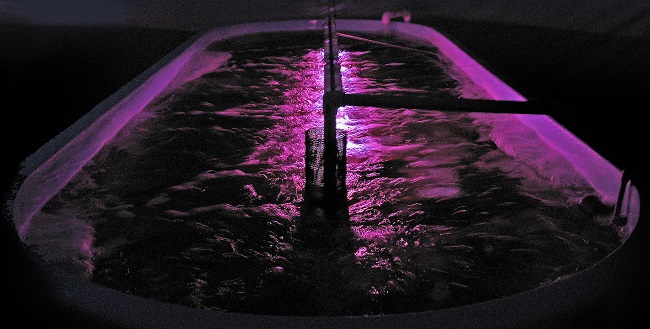
Aquaculture itself is not a new concept but the techniques developed in the 20th century have brought the practice to the forefront to combat increasingly polluted and limited water supplies. In a closed system, water is reused so the only water lost is to evaporation or cleaning, making RAS (recirculating aquaculture systems) an incredibly efficient method of production. Aquaculture is most often associated with fish farming and has become one of the fastest growing sectors of agriculture in the United States. The majority of tilapia served in restaurants or found at the store in the US is grown year- round in a carefully controlled aquaculture system using about 5% of the space required to raise fish in a pond.
Recirculating systems use a biofilter to clean and recycle the water. Not only do plants such as algae greatly reduce the amount of feed required for fish farming, but plants also reduce the environmental impact while increasing profit. Plants use carbon dioxide, water, minerals, and solar energy to power the process of photosynthesis; taking the excess nutrients in the wastewater to produce biomass which can then be used to feed the fish. Tilapia are known to eat just about anything green, and the plants are a marketable crop themselves. Integrating the culture of fish or shrimp with vegetables, micro algae, or seaweeds provides a system that can cater to many markets.
Growing micro algae or seaweed is catching on even faster than fish farming. Algae is an ingredient in many of the products we use everyday: toothpaste, ice cream, lipstick, frozen dinners, coffee creamer, bioplastic, dyes, fertilizers, and feeds. Alginate, carrageenan, and beta carotene are some of the names most used to list algae and algae derivatives. Algae provide Omega-3 and Omega-6 fatty acids essential to the diet because they cannot be made by the body. Right now, the big nut to crack is algal oil extraction for fuel use. Even without fuel as a market, over 4 billion dollars per year are spent on Seaweeds (macro algae) and micro algae such as Spirulina and Chlorella. While seaweed requires extra specialized growing conditions, micro algae(s) are comparatively easy to grow in tanks or photo bioreactors.
Commercial scale RAS aquaculture does require a large investment and high level of expertise to keep the system in balance. Businesses looking to convert an existing greenhouse to add fish or algae would be well advised to research the latest advancements and carefully consider options. I usually recommend a do-it-yourself approach but due to the intricacies involved in an aquaculture farm, this is one case that I would recommend hiring a consultant to help with planning. Once successfully implemented, there is a virtually untapped market for domestically farmed fish and algae.
Angela Lundmark enjoys gardening outdoors and indoors and freelance writer.
Related Articles & Free Email Newsletter
Aquaponics: From Fish to Fertilizer




Comment here